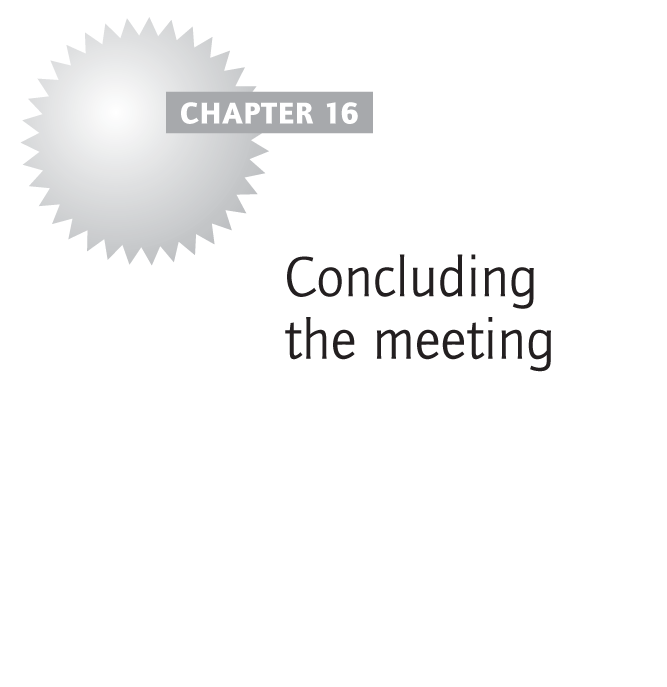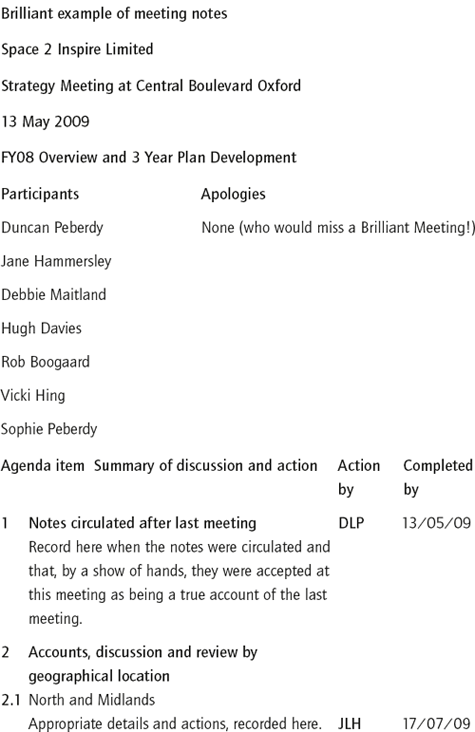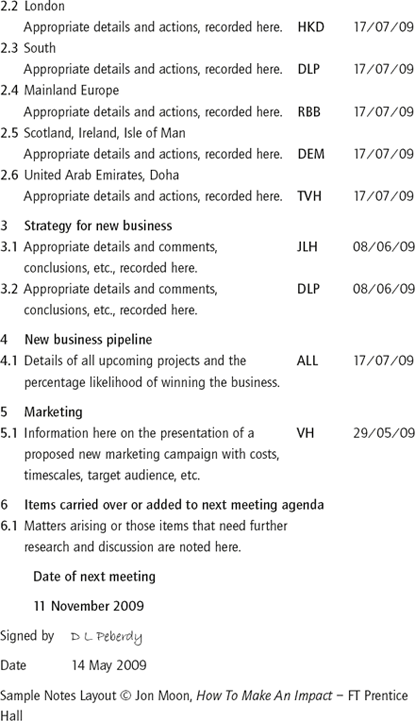Close on a high!
Just as first impressions are so important, the way you summarise and conclude your Brilliant Meeting will be the lasting impression with which your participants leave. Ensure that you allow sufficient time for a positive, inclusive, ‘on-time’ close to your meeting. This process alone will result in an effective boost to the group’s motivation.
If you have ‘parked’ questions and issues throughout the meeting it is now essential that these are addressed, or at the very least recorded and added to the agenda for any subsequent meeting. As discussed in Chapter 8, the trap of ‘Any Other Business’ should be avoided if possible, as this normally creates a meeting within a meeting, usually on items you have less control over. If any such issues are raised whilst you are closing the meeting, suggest that these too are added to the agenda for the next meeting.
An effective, timely closure to the physical gathering of the participants is vital for the good work of the meeting to continue; in many cases the work of the meeting is only just beginning. Participants need to leave the Brilliant Meeting full of enthusiasm and motivation to complete the tasks assigned to them. The following acronym will help you to CLOSE on a high:
CLOSE
Confirm and summarise discussions.
List action items and confirm meeting notes.
Outline the meeting evaluation process.
Set date/time/venue for next meeting.
Express your gratitude to everyone for their attendance and participation.
Confirm and summarise discussions
Taking each agenda item in turn, summarise the discussions that took place and where appropriate what decisions were taken. This review process has several benefits as follows:
- ensures that all agenda items have been actioned appropriately;
- confirms understanding of the discussions that took place;
- allows the note taker to check the accuracy of the notes;
- provides the participants with a sense of accomplishment and achievement.
List action items and confirm meeting notes
Following on from the agenda review and, for the same reasons, go over the list of actions that have resulted from the meeting. Taking each action in turn, seek understanding and commitment from the participant involved, taking care to reconfirm and document the timescales necessary to achieve them.
Let your participants know when they can expect to receive the meeting notes and in what format, re-iterating from whom these will originate.
Notes are intended to be an accurate, clear, concise record of the meeting, not a verbatim transcript. If you have delegated production of the notes to someone else, then these should be signed off by you as an accurate record of the meeting. Ideally, notes should be circulated within two to three days in order to maintain momentum, and in a file format that cannot be edited by recipients. Chapter 12 gives more detail on meeting notes.
At the very least, notes should include the following information:
- name of group/name of meeting;
- date and venue of meeting;
- meeting purpose;
- participants;
- apologies;
- agenda items with resulting actions;
- date of next meeting.
We receive masses of information clamouring for our attention on a daily basis. However, it is essential that meeting notes are read, giving participants a timely written reminder of their agreed actions, rather than a last-minute reminder prior to the next meeting. Increase your chances of success by using a format that is clear to read, setting out the information in an accessible way.
When we scan a set of meeting notes, we instinctively seek out from the entire document only the agenda items and actions that have our initials assigned to them. If possible, add a section towards the top of the notes that pulls together all the actions for individual participants in one place.
It does require additional work as you have to produce a set of notes tailored for each participant – but they will be the best Brilliant Meeting notes participants have ever received.
Outline the meeting evaluation process
Although this may not be a necessary action after every meeting, it is important, periodically, to collate any suggestions that your participants may have that will improve their experience in forthcoming meetings.
There are many evaluation techniques available depending on the depth of responses you are seeking. However, the golden rule is not to ask closed questions – those questions that require only a yes/no response, or a show of hands. The feedback from this would frankly be a waste of time.
When dining in a restaurant, how many times has the manager come to your table and asked, ‘How was your meal?’ Most people instinctively respond with ‘fine’ or ‘great’ or maybe even ‘fantastic’, but does this superficial feedback really help the restaurant to make improvements?
What if his question was phrased differently – ‘Excuse me, I am the restaurant manager and I was just wondering what we could have done differently to make your experience with us better?’ This question will provoke a considered response, with valuable feedback, not exclusively concerned with the quality of the food alone.
Instead, ask for responses through the use of direct, open questions designed to measure specific aspects of the meeting: venue, administration, inputs, time, etc. These questions can either be issued in paper form, or simply be put to all the participants during the meeting and receive verbal feedback that is instantly captured on a flip chart or whiteboard. This does not have to take a long time, but it works well at the end of the meeting to include feedback from everyone.
Ask participants to start their positive feedback with the following phrases:
- ‘Something that worked well was . . .’
- ‘I really liked the way . . .’
- ‘It was a great idea to . . .’
- ‘What I liked most about the meeting was . . .’
- ‘I think the major reasons for success were . . .’
Ask participants to start their formative feedback with the following phrases:
- ‘Perhaps during the next meeting we should try . . .’
- ‘I would like to cover . . . aspects in more/less detail.’
- ‘One thing I was not too comfortable with, was . . . because . . .’
- ‘I noticed that the meeting went ‘off course’ when . . .’
Another way to collate feedback is to use an electronic response system. These systems consist of individual voting handsets that are issued to each participant, with which they respond to questions posed by you. These responses are then collated and can be presented instantly in a graphical format that is visible to everyone.
As an alternative, consider using the services of a Web-based questionnaire for feedback. There are numerous companies that offer this service for a modest sum (some are even free of charge) and participants particularly like them because of their anonymity. The downside is that it takes a little time to set up, but typically anonymous responses are more measured and are more considered.
Set next meeting date/time/venue
If the meeting is one in a series, confirm when the next meeting will take place and establish if any of the participants have conflicting commitments that will prevent them from attending. If, for example, a couple of participants are on annual leave, you have the opportunity for a quick ‘round table discussion’ on alternative dates and times whilst everyone is present.
Express your gratitude to everyone for their attendance and participation
Finally, conclude the meeting formally by thanking the participants for their attendance and input. You can also take the opportunity to remind them of the next steps: their individual commitment to any actions and confirm the date of the next meeting. It is worth giving a special mention to those who have travelled extensively to be there, those who have undertaken research for a project, and to those who have delivered presentations or authored reports.

If the completed meeting ends before the scheduled time, an early close is more effective than trying to pad the meeting out.



